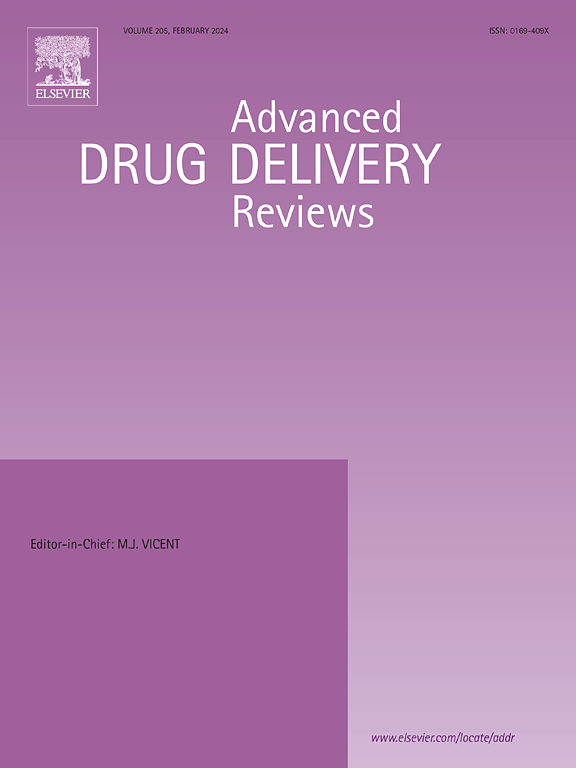基于dna的纳米结构用于肿瘤微环境反应性药物递送
IF 17.6
1区 医学
Q1 PHARMACOLOGY & PHARMACY
引用次数: 0
摘要
DNA纳米结构具有序列可编程性、生物相容性和结构通用性,已成为生物医学应用的有前途的工具,特别是在靶向药物输送和治疗干预方面。肿瘤微环境(TME)以pH梯度失调、谷胱甘肽(GSH)升高、缺氧、三磷酸腺苷(ATP)丰度和酶活性异常为特征,对传统治疗提出了重大挑战。基于dna的纳米结构能够精确控制药物装载效率、肿瘤靶向特异性和时空释放机制,使其成为肿瘤靶向药物递送的理想选择。在这篇综述中,我们重点介绍了用于精确治疗药物递送的多功能tme响应dna纳米结构的最新进展。首先,我们讨论了tme反应性药物递送中DNA纳米结构的结构配置和功能整合的基本设计原则。接下来,我们总结了TME特性,包括pH梯度、谷胱甘肽(GSH)、三磷酸腺苷(ATP)、酶活性和多种刺激,在dna纳米结构中调节治疗有效载荷的靶向和控制释放的机制。最后,本文展望了未来的研究方向,旨在进一步优化基于DNA纳米结构的药物传递系统的可设计性,强调跨学科合作的必要性。预计这些原理将促进下一代基于DNA纳米结构的药物的发展,这些药物具有智能、精确、安全和有效的治疗能力。本文章由计算机程序翻译,如有差异,请以英文原文为准。


DNA-Based nanostructures for tumor microenvironment-responsive drug delivery
DNA nanostructures, with sequence programmability, biocompatibility, and structural versatility, have emerged as promising tools for biomedical applications, particularly in targeted drug delivery and therapeutic interventions. The tumor microenvironment (TME) is characterized by dysregulated pH gradients, elevated glutathione (GSH), hypoxia, adenosine triphosphate (ATP) abundance, and aberrant enzymatic activity, presenting significant challenges for conventional therapies. DNA-based nanostructure enables precise control over drug-loading efficiency, tumor-targeted specificity, and spatiotemporal release mechanisms, making them ideal for tumor-targeted drug delivery. In this review, we highlight recent advances in versatile TME-responsive DNA-based nanostructures for precise therapeutic drug delivery. First, we discuss the fundamental design principles governing the structural configuration and functional integration of DNA nanostructures in TME-responsive drug delivery. Next, we summarize the mechanisms by which TME characteristics, including pH gradients, glutathione (GSH), adenosine triphosphate (ATP), enzymatic activity, and multiple stimuli, regulate the targeting and controlled release of therapeutic payloads in DNA-based nanostructures. Finally, this review provides an outlook on future research directions aimed at further optimizing the designability of DNA nanostructure-based drug delivery systems, underscoring the necessity of interdisciplinary collaboration. It is expected that these principles facilitate the future development of next-generation DNA nanostructure-based drugs with smart, precise, safe, and potent therapeutic capabilities.
求助全文
通过发布文献求助,成功后即可免费获取论文全文。
去求助
来源期刊
CiteScore
28.10
自引率
5.00%
发文量
294
审稿时长
15.1 weeks
期刊介绍:
The aim of the Journal is to provide a forum for the critical analysis of advanced drug and gene delivery systems and their applications in human and veterinary medicine. The Journal has a broad scope, covering the key issues for effective drug and gene delivery, from administration to site-specific delivery.
In general, the Journal publishes review articles in a Theme Issue format. Each Theme Issue provides a comprehensive and critical examination of current and emerging research on the design and development of advanced drug and gene delivery systems and their application to experimental and clinical therapeutics. The goal is to illustrate the pivotal role of a multidisciplinary approach to modern drug delivery, encompassing the application of sound biological and physicochemical principles to the engineering of drug delivery systems to meet the therapeutic need at hand. Importantly the Editorial Team of ADDR asks that the authors effectively window the extensive volume of literature, pick the important contributions and explain their importance, produce a forward looking identification of the challenges facing the field and produce a Conclusions section with expert recommendations to address the issues.

 求助内容:
求助内容: 应助结果提醒方式:
应助结果提醒方式:


